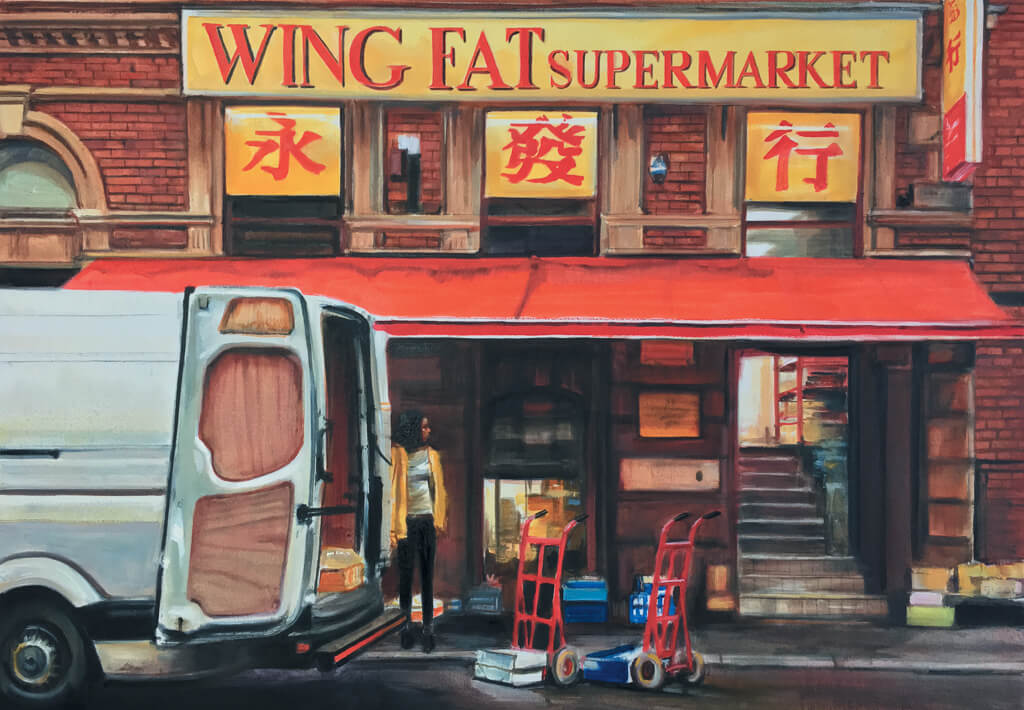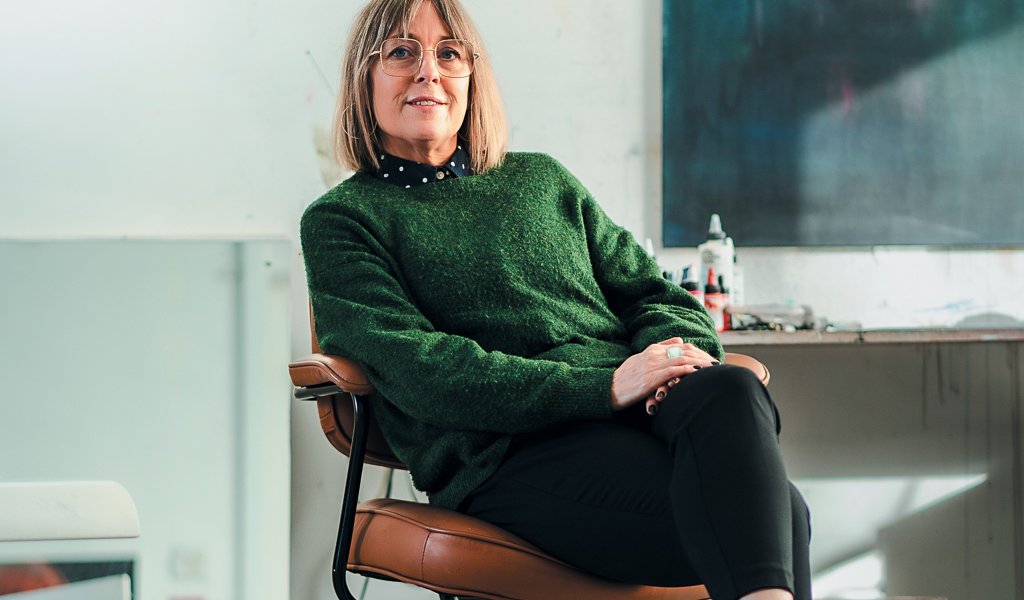Artist Georgia Peskett was known around the globe for her dramatic cityscapes before finding new inspiration – through the window of her Chesterfield home. Fiona Stubbs learns more.
FROM striking cityscapes to quiet reflections of nature, Georgia Peskett’s paintings grace galleries and art collections around the world.
Her work has been exhibited in some of the art world’s most prestigious spaces – including London’s Royal Academy, The Mall Galleries, The Shard and The Worshipful Company of Painter-Stainers.
And, for the last two decades, the creative heart of Georgia’s work has been her peaceful, unassuming studio at home in Chesterfield.
Her story, however, begins in London and New York. The daughter of renowned pop artist, installationist, muralist, set designer and art director Stan Peskett, she was born near Ladbroke Grove in West London and grew up in Richmond, Surrey.
A teenage trip to visit her father in 1980s New York – then a hotbed of artistic creativity – set Georgia on her own professional path.
She explains: “I hadn’t really known my father until then. He left the family and moved to New York in the 1970s, when I was about nine. Dad had been in the Pop Art movement in the 1960s, along with David Hockney and Derek Boshier. But he made his career in America and became well-known there.
“I first visited him at his loft space in Soho, New York when I was 15 and still at school. It was a really exciting time to be there.”
Back home, she took a Foundation course at Epsom School of Art and Design and, deciding to take a break from studying, returned to New York where she learned her craft, working alongside her father as a studio apprentice, learning techniques and skills “from the ground up”.
The art world of the late 1980s witnessed a crossover of conceptual art, contemporary expressionism, pop art and street art; with Andy Warhol, Julian Schnabel and Jean Michel Basquiat the contemporary art stars of the day.
Georgia began experimenting with surrealist painting and figuration. “It was a really good grounding in art and the art world,” she says. “It was an interesting time to be part of and a great opportunity to see first-hand how the art world worked. There was a lot of experimental, conceptual art being made.
“The first time I’d been in New York, I didn’t really go out in the city as I was so young. But the second time I was more independent, going to clubs and meeting people. Having fun!
“I was working with people on various projects, including home interiors and decorating night clubs. I worked quite a lot with special effects, such as the optical illusion style, Trompe l’oeil (which makes flat surfaces appear three-dimensional).
“At the time, people were having faux marble and faux stone effects painted in their uptown apartments and I became very good at paint effect techniques. I never saw the inhabitants, though. They’d vacate the property and go to their houses in the Hamptons or upstate Connecticut and come back when we’d finished the work.
“It was incredibly hard work. I was running and cycling from place to place as it was the cheapest way to travel. I was also in and around the East Village quite a lot. It was still quite run down then – it had an ‘edge’.
“We moved around, too. As well as the loft in the city, we also had a working studio in Hampton Bays – a more blue collar area of Long Island.”
One of Georgia’s New York paintings was spotted by an art dealer and sold to an investment banker. “That was a big break for me,” she recalls. “I was astounded – I was only about 19 or 20. It was a large cityscape of the Bowery – full of characters.”

She went on to spend a few years alternating between New York and London – earning money through waitressing and working on freelance illustration commissions before committing to becoming a full-time painter.
Her decision, in the early Nineties, to be based entirely in the UK coincided with the rise of the Young British Artists (YBA) movement – based around graduate artist-led exhibitions in warehouses and factories. Advertising executive and art collector Charles Saatchi was a leading supporter and sponsor of the movement.
But, says Georgia, “I wanted no part of that. I didn’t want to go to university and take that conceptual path. I was painting and illustrating and doing some commercial work and, for a while, I didn’t really have anywhere to exhibit my art.
“It took around a decade to establish my style of painting. It can take a while to find your ‘look’ as an artist, your genre. It’s not a particularly easy path. It’s not just about the painting – there’s a great deal of admin, planning for exhibitions, transportation of your work. There’s a lot of discipline involved – you have to have disciplined routines.”
Georgia’s urban landscapes, inspired by New York and London, found an appreciative audience in galleries across the capital. Some are now with notable private and public collections around the world, including the BT Telecom Collection in London, Bentley Headquarters in Cheshire and The Earl of Chichester, Verve Properties London.
Georgia is quietly modest, but admits: “There’s a sense of achievement when other people are enjoying my work. It’s an honour that they like them enough to have them in their collections.”
She exhibits nationally and locally – notable spaces include the Royal Academy in London, Wells Cathedral, the Irving Gallery, Oxford and Sheffield’s Fronteer Gallery.
In recent years, Georgia’s style of painting has evolved into a gentler, reflective genre. “I spent around 20 years painting urban landscapes,” she explains. “It was interesting but for me, personally, I felt it had run its course. As an artist, you get curious; things change and other things come in.”
A catalyst for change came with the arrival of Covid-19 and lockdown. She says: “We were in a global pandemic and it made me re-evaluate everything. Where was I? Where did I want to go next with my work?
“I’d previously been making visits to London, New York and various cities but now there was no travel. Everything stopped and my focus changed. My subjects completely altered.
“It felt like a natural change. I joined a few online groups as there was so much isolation and I wanted to connect with peers. I joined the Turps correspondence course – like an online art school – and got regular feedback from mentors and other artists. I found it really helpful and it spurred me on to look at other things right in front of me.”
She adds: “It was quite a traumatic time for all of us and I think that, as an artist, we use these experiences to inform our work. I process the things that happen to me through my art.
“In spring 2020, the magnolia in the garden was starting to come out. The magnolia was blooming outside but I was inside, looking out; painting things I was seeing through windows. It was a new way of working and a new way of looking at the world…through veils and barriers.”
From those early days of lockdown, Georgia’s new, contemplative style emerged. “There are echoes of (impressionist painter) Monet and (modernist painter) Manet,” she says. “These paintings are about reflecting on life. There’s a memento-mori quality. The pandemic made us all question our fragility, our mortality.
“As a mature artist, this also comes into your own life, examining the stage you are now at. When you’re painting in an authentic way, it’s an organic progression. We absorb what’s happening in our immediate environment. The beauty of nature is now part of my work, more than it was before.”
Georgia paints on vegan silk stretched over boards and canvasses, creating a smooth, soft – almost translucent – surface to work on. Each painting – in oils, acrylics or, sometimes, both – begins with a photograph, though her work is not photographic in style.
Throughout this year, she is sharing her expertise through a series of seasonal Mindful Painting workshops in the Walled Garden Workshop at Libby’s, Chatsworth Road.
“Art is fantastic for people’s wellbeing,”
Georgia Peskett
“Art is fantastic for people’s wellbeing,” says Georgia. “Discovering ways of working mindfully is very helpful for conditions including stress, anxiety and menopause. It lowers your heart rate and levels of (stress hormone) cortisol. Anything that slows you down and gives you the opportunity to switch off, put worries out of your mind and just focus on that activity is very beneficial.”
Chesterfield is now very much home to Georgia, after moving here from London 21 years ago with her partner, Matt.
“Matt was originally from Chesterfield and, when we decided to leave London, it made sense to move here,” she says. “It’s on the edge of the Peak District and such a great central location – convenient for travel to exhibitions in all parts of the country. I feel very much a part of Chesterfield – I’m ‘Derbyshire’ now.”
Georgia will be leading a Mindful Painting workshop on Saturday, May 25 (10am to 1pm) at Libby’s Walled Garden Workshop. Check the Workshop section on Georgia’s website (below) for further dates.
Learn more about Georgia’s work and upcoming exhibitions at https://www.georgiapeskett.com/ or on Instagram @georgiapeskett






